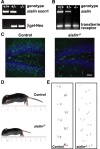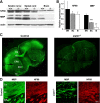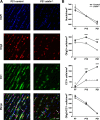The lysosomal sialic acid transporter sialin is required for normal CNS myelination
- PMID: 20007460
- PMCID: PMC2820501
- DOI: 10.1523/JNEUROSCI.3005-09.2009
The lysosomal sialic acid transporter sialin is required for normal CNS myelination
Abstract
Salla disease and infantile sialic acid storage disease are autosomal recessive lysosomal storage disorders caused by mutations in the gene encoding sialin, a membrane protein that transports free sialic acid out of the lysosome after it is cleaved from sialoglycoconjugates undergoing degradation. Accumulation of sialic acid in lysosomes defines these disorders, and the clinical phenotype is characterized by neurodevelopmental defects, including severe CNS hypomyelination. In this study, we used a sialin-deficient mouse to address how loss of sialin leads to the defect in myelination. Behavioral analysis of the sialin(-/-) mouse demonstrates poor coordination, seizures, and premature death. Analysis by histology, electron microscopy, and Western blotting reveals a decrease in myelination of the CNS but normal neuronal cytoarchitecture and normal myelination of the PNS. To investigate potential mechanisms underlying CNS hypomyelination, we studied myelination and oligodendrocyte development in optic nerves. We found reduced numbers of myelinated axons in optic nerves from sialin(-/-) mice, but the myelin that was present appeared grossly normal. Migration and density of oligodendrocyte precursor cells were normal; however, a marked decrease in the number of postmitotic oligodendrocytes and an associated increase in the number of apoptotic cells during the later stages of myelinogenesis were observed. These findings suggest that a defect in maturation of cells in the oligodendrocyte lineage leads to increased apoptosis and underlies the myelination defect associated with sialin loss.
Figures








Similar articles
-
Sox2 Is Essential for Oligodendroglial Proliferation and Differentiation during Postnatal Brain Myelination and CNS Remyelination.J Neurosci. 2018 Feb 14;38(7):1802-1820. doi: 10.1523/JNEUROSCI.1291-17.2018. Epub 2018 Jan 15. J Neurosci. 2018. PMID: 29335358 Free PMC article.
-
Progressive leukoencephalopathy impairs neurobehavioral development in sialin-deficient mice.Exp Neurol. 2017 May;291:106-119. doi: 10.1016/j.expneurol.2017.02.009. Epub 2017 Feb 9. Exp Neurol. 2017. PMID: 28189729
-
Sialin expression in the CNS implicates extralysosomal function in neurons.Neurobiol Dis. 2004 Mar;15(2):251-61. doi: 10.1016/j.nbd.2003.11.017. Neurobiol Dis. 2004. PMID: 15006695
-
Free sialic acid storage disorder: Progress and promise.Neurosci Lett. 2021 Jun 11;755:135896. doi: 10.1016/j.neulet.2021.135896. Epub 2021 Apr 20. Neurosci Lett. 2021. PMID: 33862140 Free PMC article. Review.
-
Mechanisms regulating the development of oligodendrocytes and central nervous system myelin.Neuroscience. 2014 Sep 12;276:29-47. doi: 10.1016/j.neuroscience.2013.11.029. Epub 2013 Nov 22. Neuroscience. 2014. PMID: 24275321 Review.
Cited by
-
SLC17: a functionally diverse family of organic anion transporters.Mol Aspects Med. 2013 Apr-Jun;34(2-3):350-9. doi: 10.1016/j.mam.2012.05.004. Mol Aspects Med. 2013. PMID: 23506876 Free PMC article. Review.
-
Modeling Rare Human Disorders in Mice: The Finnish Disease Heritage.Cells. 2021 Nov 13;10(11):3158. doi: 10.3390/cells10113158. Cells. 2021. PMID: 34831381 Free PMC article. Review.
-
Sialic acids in the brain: gangliosides and polysialic acid in nervous system development, stability, disease, and regeneration.Physiol Rev. 2014 Apr;94(2):461-518. doi: 10.1152/physrev.00033.2013. Physiol Rev. 2014. PMID: 24692354 Free PMC article. Review.
-
Synapse location during growth depends on glia location.Cell. 2013 Jul 18;154(2):337-50. doi: 10.1016/j.cell.2013.06.028. Cell. 2013. PMID: 23870123 Free PMC article.
-
Is Aspartate an Excitatory Neurotransmitter?J Neurosci. 2015 Jul 15;35(28):10168-71. doi: 10.1523/JNEUROSCI.0524-15.2015. J Neurosci. 2015. PMID: 26180193 Free PMC article.
References
-
- Autio-Harmainen H, Oldfors A, Sourander P, Renlund M, Dammert K, Simila S. Neuropathology of Salla disease. Acta Neuropathol. 1988;75:481–490. - PubMed
-
- Barranger JA, Cabrera-Salazar MA. Lysosomal storage disorders. New York: Springer; 2007.
-
- Barres BA. The mystery and magic of glia: a perspective on their roles in health and disease. Neuron. 2008;60:430–440. - PubMed
-
- Barres BA, Hart IK, Coles HS, Burne JF, Voyvodic JT, Richardson WD, Raff MC. Cell death and control of cell survival in the oligodendrocyte lineage. Cell. 1992;70:31–46. - PubMed
Publication types
MeSH terms
Substances
Grants and funding
LinkOut - more resources
Full Text Sources
Other Literature Sources
Molecular Biology Databases
